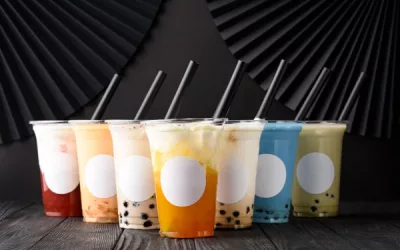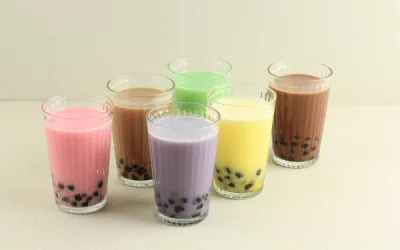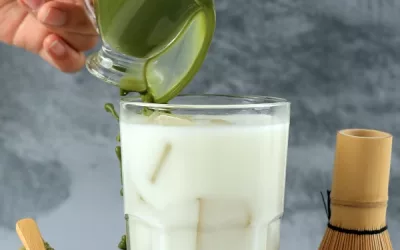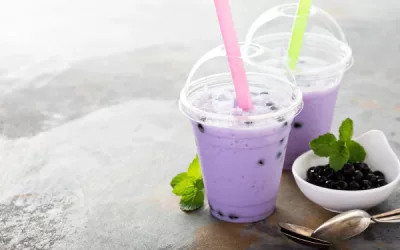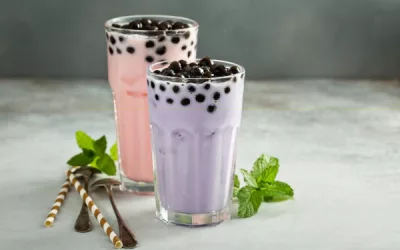Have you ever wondered how a simple drink can stir up a world of flavour and health benefits? Enter matcha boba tea, a delightful fusion of rich matcha powder and chewy tapioca pearls that has taken the beverage scene by storm. This guide is essential for anyone eager to craft this trendy drink from the comfort of their kitchen, exploring its ingredients, preparation methods, and customization options. Let’s dive in and discover the magic behind matcha boba, unlocking its health perks and culinary versatility!
Table of Content
- What is matcha boba tea?
- How do you prepare matcha boba tea?
- What are the health benefits of matcha?
- How does matcha compare to other teas in terms of health benefits?
- Can matcha help with weight loss?
- What are the potential side effects of consuming matcha?
- What types of milk can be used for matcha boba?
- How do you cook tapioca pearls?
- How can you customise matcha boba tea?
- Where can you buy matcha and tapioca pearls?
- What are some tips for storing matcha boba tea?
- Conclusion
What is matcha boba tea?
Matcha boba tea, also known as matcha bubble tea, combines two iconic elements of Asian cuisine: Japanese matcha powder and Taiwanese boba pearls. You might see it at trendy cafes or even make it at home. The unique blend includes a few key ingredients, which together create a refreshing and slightly chewy drink.
This beverage starts with matcha, a finely ground green tea powder known for its vibrant green colour and rich, earthy flavour. Matcha offers a more concentrated flavour compared to regular green tea because you’re consuming the entire tea leaf.
Tapioca pearls, or boba, add a chewy texture and fun experience to each sip. Typically, the drink is completed with plant-based milk and a touch of sweetness, often honey or simple syrup.
What are the main ingredients of matcha boba tea?
Matcha boba tea is a delightful drink that brings together several key components:
- Matcha Powder: Made from ground green tea leaves, offering a full-bodied, earthy flavour.
- Tapioca Pearls: Also known as boba; these chewy balls made from tapioca starch add texture.
- Plant-Based Milk: Common choices include almond, soy, or oat milk for a creamy base.
- Sweeteners: Options like honey, agave syrup, or simple syrup to balance the bitterness of matcha.
- Optional Add-ins: Some variations include fruit syrups or jellies for an extra twist.
Combining these ingredients creates a drink that’s not only tasty but also visually appealing. The vibrant green of the matcha contrasts beautifully with the dark tapioca pearls.
How does matcha differ from regular green tea?
Matcha and regular green tea both come from the Camellia sinensis plant, but their preparation and characteristics are quite different:
- Preparation: Matcha involves finely grinding whole tea leaves, whereas green tea is typically brewed from dried leaves.
- Concentration: Matcha is more concentrated since you consume the entire leaf, providing more antioxidants and nutrients.
- Flavour: Matcha offers a richer, earthier flavour, while green tea tends to be lighter and more floral.
- Colour: Matcha’s vibrant green hue comes from its high chlorophyll content due to shade-growing techniques.
These differences make matcha a more potent source of antioxidants and a richer flavour experience compared to regular green tea.
What makes boba tea unique?
Boba tea stands out for several reasons, making it a favourite among many:
- Texture: The chewy tapioca pearls provide a unique, enjoyable texture.
- Variety: You can customise it with various teas, milk types, and flavours.
- Aesthetics: The layered look of the drink is visually pleasing.
- Cultural Fusion: Combines elements of Taiwanese drink culture with other global flavours.
- DIY Friendly: You can easily make it at home with a few key ingredients.
These features make boba tea a versatile and engaging beverage that’s perfect for social media snaps and personal enjoyment alike.
Around 2000 AD, bubble tea started to gain international fame, with matcha boba becoming a standout variant due to its unique combination of Japanese and Taiwanese elements. The trend began in Taiwan in the 1980s when tea shops experimented with adding tapioca pearls to their iced tea drinks.
This simple yet innovative idea quickly spread across Asia and eventually the world. Today, bubble tea shops are almost everywhere, offering countless variations that cater to all sorts of tastes.
I remember the first time I made matcha boba tea at home. I was intrigued by its distinctive green hue and wanted to see if I could replicate the cafe experience.
I whisked the matcha powder with hot water, cooked the tapioca pearls until they were perfectly chewy, and combined them with almond milk and a touch of honey. The result was a refreshing treat that felt like a small victory and a delicious way to enjoy an afternoon break.
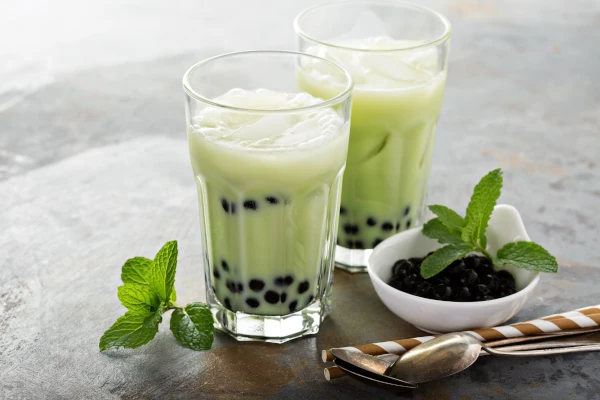
How do you prepare matcha boba tea?
Preparing matcha boba tea at home is a fun and rewarding process, allowing you to customise the sweetness and texture to your liking. This delightful drink combines the earthy taste of matcha with the chewy goodness of tapioca pearls.
Below, you’ll find a detailed table to guide you through the ingredients, their quantities, the preparation steps, and the cooking times. Use this table as a handy reference while you make your tea.
| Ingredients | Quantities | Preparation Steps | Cooking Times |
|---|---|---|---|
| Tapioca pearls | 1/2 cup | Boil in water until they float, then simmer | 5-10 minutes |
| Water | 4 cups | Bring to a boil | N/A |
| Matcha powder | 2 teaspoons | Whisk with hot water until frothy | 1-2 minutes |
| Hot water | 1/4 cup | Use to dissolve matcha powder | N/A |
| Milk of choice | 1 cup | Chill in the fridge | N/A |
| Sweetener (honey, sugar) | 1-2 tablespoons | Mix with cooked tapioca pearls | 1-2 minutes |
| Ice cubes | 1 cup | Add to the glass before serving | N/A |
Using and understanding this table is straightforward. The first column lists the ingredients you’ll need. The second column provides the exact quantities required. The third column gives you a step-by-step guide on what to do with each ingredient.
The fourth column indicates how long each step will take.
What are the key ingredients for matcha boba tea?
Matcha boba tea relies on a few key ingredients to achieve its unique flavour and texture.
- Matcha powder: This finely ground green tea powder is known for its vibrant colour and earthy taste.
- Tapioca pearls: These chewy balls bring a fun texture to the drink.
- Milk: You can use any milk you prefer, such as cow’s milk, almond milk, or oat milk.
- Sweetener: Honey, sugar, or even condensed milk are popular choices.
- Ice cubes: These help to chill the drink, making it refreshing.
Each ingredient plays an essential role. The matcha powder gives a distinct flavour, the tapioca pearls add chewiness, the milk provides creaminess, the sweetener balances the bitterness, and the ice cubes make the drink pleasantly cool.
What are the health benefits of matcha boba tea?
Matcha boba tea not only tastes great but also offers several health benefits.
- Rich in antioxidants: Matcha contains catechins, which are natural antioxidants.
- Boosts metabolism: The caffeine and antioxidants in matcha can help improve metabolic rates.
- Enhances mood and concentration: L-theanine, an amino acid in matcha, promotes relaxation without drowsiness.
- Detoxifies the body: Matcha can help cleanse and detoxify the body.
- Rich in fibre: Tapioca pearls provide a good source of dietary fibre.
Matcha boba tea is more than just a tasty treat; it offers various health benefits, making it a smart choice for those who love indulging in delicious yet nutritious beverages.
In the late 16th century, Japanese tea master Sen no Rikyū played a significant role in developing the Japanese tea ceremony, known as “chanoyu”. His refined techniques and philosophies emphasised the beauty of simplicity and the importance of serene preparation.
Though the ceremony originally utilised traditional matcha, the spirit of meticulous preparation can be seen today in how we make matcha boba tea, blending ancient practices with modern tastes.
What are the health benefits of matcha?
Alright, let’s cut to the chase. You’re here because you’re curious about matcha and its supposed magical health benefits. And boy, does it come with a list of perks.
First up, matcha is packed with antioxidants. This stuff can help you fight the bad guys in your body—think free radicals. It’s basically your body’s version of a superhero cape. Then, there’s the energy boost. You know how coffee gives you wings but then sends you crashing into the ground? Matcha gives you a more steady, less insane kind of energy kick.
Speaking of kicks, matcha can also give your metabolism a boost. So if you’ve got that “I need to burn some calories” thing going on, it might be your new best friend. Stress reduction? Yep, matcha’s got that too, thanks to its L-theanine content.
Finally, let’s stir in some potential cancer-fighting properties. Matcha contains catechins that may arm your body against various types of cancer.
How does matcha compare to other teas in terms of health benefits?
So, how does matcha stack up against its tea cousins? Think of it as the overachieving sibling.
- Antioxidants: Matcha has up to 137 times more catechins than regular green tea. Stick that in your teapot and brew it.
- Energy Boost: Thanks to its combination of caffeine and L-theanine, matcha offers a more sustained energy boost compared to coffee or other teas.
- Metabolism Enhancement: Green tea in general is great for metabolism, but matcha seems to take it to the next level.
- Stress Reduction: That L-theanine not only gives you calm-focused energy but also minimizes stress better than your standard cup of Earl Grey.
- Cancer-Fighting Properties: Those abundant catechins might help ward off different types of cancer, making matcha a champ in this arena.
Matcha isn’t just another tea; it’s the one standing at the front of the class, raising its hand for every question.
Can matcha help with weight loss?
If you’re wondering whether matcha can help you lose those extra pounds, it might be time to pay attention.
- Boosts Metabolism: Matcha increases thermogenesis, which is the rate at which your body burns calories.
- Burns Fat: If you’re hitting the gym, matcha can make your workout more efficient by enhancing fat oxidation.
- Reduces Appetite: Drinking matcha before meals might help control your cravings, keeping you from raiding the snack cupboard.
- Low-Calorie: At only a few calories per serving, matcha doesn’t pack the pounds on your waistline.
- Natural Sweetness: It’s naturally sweet and can serve as a healthy alternative to sugar-laden drinks.
In short, matcha can be a solid part of your weight loss strategy, especially when paired with a balanced diet and exercise.
What are the potential side effects of consuming matcha?
Now, let’s not get carried away with the green goodness. Matcha, like everything else, has a downside if you’re not careful.
- Caffeine Sensitivity: While matcha has less caffeine than coffee, it’s still there. If you’re sensitive to caffeine, watch out for jitters, insomnia, or palpitations.
- Tummy Troubles: Consuming too much might mess with your stomach, causing nausea or an upset stomach.
- Heavy Metals: Some matcha can contain traces of lead or other heavy metals. Choose quality brands to minimise this risk.
- Allergies: Rare, but if you’re allergic to green tea, stay away from matcha. It’s essentially super-condensed green tea.
- Health Conditions: If you have certain health conditions, like kidney problems, high amounts of matcha might not be for you.
A little caution goes a long way. Enjoy your matcha, but don’t drown yourself in it.
In the ancient days of Japan, matcha was consumed by monks to support their long hours of meditation. These guys knew what they were doing. One monk, Eisai, even wrote a whole book about tea’s health benefits called “Kissa Yojoki.”
Imagine sitting down to pen an entire manuscript on tea just because you’re that passionate about it. That’s how you know matcha isn’t just a passing fad.
So go ahead, whip up a matcha boba or any other matcha concoction. Just remember, everything in moderation, even the good stuff. Cheers to your health!
What types of milk can be used for matcha boba?
When it comes to matcha boba, the choice of milk can make or break the drink. This versatile beverage doesn’t discriminate; it works well with a myriad of milk options. Whether you’re a traditionalist craving dairy or a plant-based enthusiast, let’s dive into the milky madness and explore what works best for your matcha boba experience.
Dairy milk for matcha boba
Starting with the classic. Dairy milk, whether it’s whole, skimmed, or semi-skimmed, provides a creamy texture and rich taste. It’s like the vanilla ice cream of the milk world—always reliable and universally loved.
- Whole milk: Seriously creamy, with a rich mouthfeel making your matcha boba taste indulgent.
- Skimmed/semi-skimmed milk: Offers a lighter, less fatty version of the classic, still retaining some of that creamy goodness.
- Lactose-free milk: For those who can’t stomach lactose but still want the familiar taste of dairy.
While dairy milk gives that traditional creamy richness, it comes with lactose, and not everyone thrives on that. So, moving on to the plant-based gang!
Almond milk for matcha boba
Almond milk is like that skinny fit friend who still manages to have a crazy amount of energy. It’s light, slightly nutty, and goes surprisingly well with matcha.
- Unsweetened almond milk: Fewer calories, no added sugars; perfect if you’re watching your waistline.
- Sweetened almond milk: Adds a touch of sweetness, balancing out the matcha bitterness.
- Vanilla almond milk: Extra flavour kick for those who like their drinks a bit more spirited.
Oat milk for matcha boba
Oat milk is the hipster’s choice. Smooth, creamy, and perfect for frothing – it hits just the right notes. Plus, it’s great for the environment!
- Regular oat milk: Creamy, neutral taste, letting the matcha shine.
- Barista blend: Extra creamy, especially formulated to froth and foam like a dream.
Coconut milk for matcha boba
For a bit of tropical flair, coconut milk adds a unique twist. It’s creamy, but with a distinctly coconutty flavour that might steal the spotlight from matcha if not balanced carefully.
- Full-fat coconut milk: Decadent, creamy – almost dessert-like.
- Light coconut milk: Less heavy but still carries that unmistakable coconut undertone.
- Coconut milk blends: Combined with other plant-based milks to balance out the coconut flavour.
Soy milk for matcha boba
Soy milk is the old guard of dairy alternatives. It’s thick, creamy, and has a neutral taste, making it a great partner for matcha. Plus, it’s loaded with protein!
- Regular soy milk: Creamy and mild, a neutral backdrop for matcha.
- Flavoured soy milk: Adds an extra dimension, just ensure it doesn’t clash with the matcha’s delicate taste.
Which milk option is the healthiest?
If you’re counting calories or watching your health metrics, here’s what you need to know. Almond milk often comes up as the lowest in calories and sugars, especially if you opt for the unsweetened variety. It’s a great choice for anyone looking to cut down on calorie intake without sacrificing flavour.
Oat milk, while higher in calories, packs in more fibre and can be a good option for those focusing on digestion. Dairy milk, despite its creamy benefits, tends to be higher in fats and sugars (unless you choose skimmed, but then you lose some creaminess).
Soy milk wins on the protein front, making it a robust choice for a power-packed drink.
- Almond milk: Lowest in calories, minimal sugars (unsweetened)
- Oat milk: Higher in calories but a good source of fibre
- Dairy milk: Levels vary, but generally higher in fats and sugars
- Soy milk: High in protein, making it a fulfilling choice
- Coconut milk: Higher in fats, distinct coconut flavour
How do different milks affect the flavour of matcha boba?
The milk you choose will significantly alter the drink’s taste and texture. Whole milk gives it a creamy richness, almost turning your boba into a liquid dessert. Skimmed versions lighten it up. Almond milk brings a subtle nuttiness, while oat milk balances creaminess with a mild taste, letting the matcha take centre stage.
Coconut milk – love it or hate it – brings a strong tropical flavour that pairs interestingly with matcha’s earthiness. Soy milk, meanwhile, offers a consistency comparable to dairy milk, with a more neutral flavour that complements rather than competes with the tea.
Can I use non-dairy milk alternatives?
Absolutely! Non-dairy milk alternatives have become indispensable not just for the lactose-intolerant, but for anyone diversifying their diet. They provide varied flavours and textures to your matcha boba, each adding its own slight twist to the drink.
Whether it’s almond, oat, coconut, or soy, these alternatives accommodate a range of dietary needs and preferences without sacrificing the creamy experience.
- Lactose intolerance: Non-dairy milks are perfect for avoiding digestive issues.
- Dietary preferences: Whether vegan, paleo, or just adventurous, there’s an option for you.
- Flavour variety: Adding unique twists to your matcha boba.
- Sustainability: Many non-dairy options, like oat milk, have smaller carbon footprints.
Choosing the right milk for your matcha boba can be a game-changer. Modern beverages, like matcha boba, blend tradition with innovation and can be customized to fit personal tastes and dietary needs.
Did you know? Japanese tea master Sen no Rikyū, during the late 1500s, revolutionised the tea ceremony by emphasising simplicity and natural beauty. He believed in enjoying tea with the fewest of extraneous elements, blending form and function in an artful dance.
Imagine his curiosity if he tasted today’s matcha boba – a fusion of old and new worlds, blending tradition with modern health trends. A true testament to how food and drink evolve, yet continue to honour their roots.
How do you cook tapioca pearls?
Alright, let’s get down to brass tacks. Cooking tapioca pearls may sound like a daunting task, but it’s really just about nailing the basics. Think of it as a three-step dance: soak, boil, and marinate. Done right, you’ll get those perfectly chewy pearls for your matcha boba or any other bubble tea magic you’re concocting.
First up is soaking. Tapioca pearls need a good soak to soften up before they face the boiling wrath. Skipping this part is like trying to eat uncooked beans—hard and unpleasant. The pearls need at least 30 minutes in lukewarm water, but if you’re patient, an hour is even better.
Once your pearls have soaked, they should be plump and ready to embrace the boiling water.
Now, onto boiling. Dump the soaked pearls into a pot of boiling water. Here’s a chef’s tip: use a lot of water, like you’re cooking pasta. Stir occasionally to prevent sticking. Boil those bad boys for about 20-30 minutes until they become translucent with a chewy texture.
Don’t overdo it; mushy pearls are a crime against bubble tea lovers everywhere.
After boiling, it’s all about marinating. Transfer the cooked pearls to a bowl of cold water to stop them from cooking further. This also gives them that lovely chewiness we all crave. You can then toss them in some sugar syrup or sweetened tea to let them soak up some flavour.
Store them properly to keep that fresh-made texture, and you’ve got yourself pearls ready to boba-fy your day.
How long should I cook tapioca pearls?
The cooking part is crucial, my friend. You don’t want to end up with either rock-hard or mushy pearls, right?
- Soaking: 30-60 minutes.
- Boiling: 20-30 minutes.
- Rinsing/Marinating: 10 minutes in cold water.
- Total Time: 60-100 minutes, depending on how rigorous your timing is and how chewy you like your pearls.
After all that effort, you deserve a perfect cup of matcha boba with pearls that have just the right bite to them. Overcooking makes them mushy, while undercooking gives you a jaw workout. Follow the golden window of 20-30 boiling minutes, and you will be the matcha boba hero we all need.
What is the best way to store cooked tapioca pearls?
Cooked pearls won’t last forever, unfortunately. But with the right storage methods, you can extend their delicious life.
- Cool water bath: Keep them in a bowl of cool water if you’re using them within a couple of hours. This maintains their chewy texture.
- Simple syrup: For longer storage, immerse them in simple syrup (1:1 ratio of sugar and water). This keeps them sweet and chewy for up to 24 hours.
- Air-tight container: Store your syrup-soaked pearls in an airtight container at room temperature. This prevents them from drying out and becoming gummy.
Remember, cooked tapioca pearls are best enjoyed fresh. After 24 hours, they start to lose that delightful chewiness, making your boba experience less than ideal.
Can I reuse leftover tapioca pearls?
Leftover pearls might make you wonder if they’re destined for the bin. But hold on, there’s some hope!
- Revive with boiling water: Reboil pearls for about 5-10 minutes to bring back some chewiness.
- Microwave magic: Pop them in the microwave for 30-second intervals in a bit of water to soften them up.
- Sweet storage: Refresh them in a new batch of simple syrup for a quick pick-me-up.
However, be mindful that pearls lose their perfect texture over time. Reusing is possible, but there’s no beating freshly cooked tapioca pearls. The fresher, the better.
Speaking of timeless texture, consider the origin of matcha boba itself. Originating from Taiwanese bubble tea culture that started in the 80s, the marriage of matcha and boba pearls had to start somewhere.
Matcha, the powdered green tea marvel, has centuries of history in Japanese tea ceremonies. Combine that with the chewy delight of tapioca pearls, and you’ve harnessed a bit of global tea history in your cup.
Legends speak of monks enjoying matcha to stay awake during meditation—just imagine their surprise if they had a caffeine-packed matcha boba instead. What a wake-up call that would be!
Now, go forth and conquer the world of tapioca pearls for your matcha boba. Retry, perfect, and enjoy your chewy success.
How can you customise matcha boba tea?
Think of matcha boba tea like a blank canvas, ready for your brushstrokes of flavour, sweetness, and style. The trick here is customisation, making it as unique as your fingerprints. Whether you’re a boba newbie or a seasoned tea connoisseur, let’s dive into the art of making matcha boba truly your own.
Start with sweetness levels. Are you a sugar addict, or do you cringe at the sight of a cupcake? Adjust the sweetness to your liking. Then there’s flavour additions. Want a kick of vanilla? Or how about a splash of coconut? The sky’s the limit. Don’t forget those chewy pearls.
Your boba doesn’t have to be limited to just tapioca. You can explore crystal boba, fruit jelly, and more. Milk choices also play a crucial role. Whether you’re a dairy devotee or nut milk enthusiast, there’s a plethora to choose from.
Finally, consider serving styles. Hot or cold? In a tall glass or a cute mason jar? Decisions, decisions.
What are some popular flavour combinations?
When it comes to popular flavour combinations, think of your taste buds attending a vibrant party.
- Classic Matcha Honey Milk Tea: Matcha and honey—a timeless duo.
- Matcha Coconut Delight: Add coconut milk for a tropical twist.
- Matcha Vanilla Dream: Infuse with vanilla syrup for that sweet allure.
- Mint Matcha Magic: A touch of mint syrup can make your drink refreshing.
- Berry Matcha Fusion: Blend in some berry syrup for a fruity punch.
These combos aren’t one-size-fits-all. Mix and match till you hit the jackpot for your palate.
How can I make my matcha boba less sweet?
If you’re steering clear of a sugar rush that could rival a toddler’s birthday party, here’s how to keep that sweetness in check.
- Cut Down on Syrup: Just say no to that extra pump.
- Use Natural Sweeteners: Opt for honey or agave instead of refined sugar.
- Less Sweet Boba: Get those less sweet tapioca pearls if available.
- Milk Alternatives: Some plant-based milks like almond or coconut have a naturally subtle sweet taste.
- Dilute the Sweetness: More ice or extra water can tone down the sugar.
By making these tweaks, you’ll be sipping a drink that’s as balanced as a tightrope walker but without the bellyache.
Can I add fruit to my matcha boba?
Absolutely, fruit and matcha boba are a match(a) made in heaven.
- Fruit Purees: Mango, strawberry, or peach puree can add a burst of flavour.
- Fresh Fruit Slices: Pop in some kiwi, strawberries, or blueberries.
- Fruit Jellies: Swap traditional boba for fruit-based jellies.
- Fruit Syrups: Add a drizzle of passion fruit or raspberry syrup.
- Citrus Zest: A hint of lemon or orange zest can brighten up your drink.
Adding fruit not only ups your drink’s aesthetic but also brings a freshness that can cut through matcha’s earthy notes.
Back in the 16th century, matcha first made waves in Japan, being originally used by Zen Buddhist monks for meditation purposes. Talk about a glow-up! Fast forward to now, and it has evolved from a pious ritual to an Instagram sensation, all while keeping its nutritional benefits.
So, as you customise your matcha boba, know you’re sipping on something steeped (pun intended) in history and culture.
Where can you buy matcha and tapioca pearls?
Alright, so you’ve decided to dive into the glorious, green world of matcha boba. Good call, my friend! To get started, you need high-quality matcha and tapioca pearls. So, where do you find these magical ingredients without embarking on some epic quest? Let’s break this down.
You’ve got choices, and plenty of them. From the digital labyrinth of online retailers to the quaint aisles of farmer’s markets, options abound:
Online retailers
- Reliability: Many online stores specialise in high-quality matcha and pearls. Think Amazon, eBay, and even specialised tea retailers like David’s Tea or Matcha Love.
- Selection: You get a wide variety to choose from, ranging from ceremonial grade to culinary grade matcha.
- Convenience: Order from the comfort of your couch. Also, free shipping is the cherry on top.
Local Asian grocery stores
- Authenticity: They often carry brands straight from Asian countries, ensuring authentic taste and quality.
- Cost-effective: Prices are usually more competitive compared to specialty shops.
- Availability: Fresh stock means you get fresh ingredients.
Specialty tea shops
- Expertise: These places offer top-notch matcha and might also educate you on its history, quality, and health benefits.
- Quality: Generally, you’ll find premium grades here.
- Variety: They often have unique blends you won’t find elsewhere.
Health food stores
- Organic options: For the health-conscious, these stores usually stock organic matcha and tapioca pearls.
- Quality control: Health stores have quality standards that can ensure you’re getting good stuff.
- Eco-friendly packaging: If you’re an eco-warrior, this is your jam.
Farmer’s markets
- Freshness: Nothing beats the quality of fresh, locally sourced goods.
- Support local: You’re backing local businesses and farmers.
- Unique finds: Sometimes you find rare, artisanal varieties you’d never stumble upon in regular stores.
So, there you have it. Now, let’s dig into the specifics to make sure you’re not wasting your money on swamp water and knock-off pearls.
What should I look for when buying matcha?
First off, don’t grab the first neon-green powder you see.
- Grade: Ceremonial grade for drinking, culinary grade for cooking. Don’t mix these up unless you enjoy disappointment.
- Origin: Authentic Japanese matcha is your target. China produces matcha too, but the quality can be inconsistent.
- Colour: Vibrant, bright green. Anything dull or yellowish is a big no-no.
- Texture: Fine powder, smooth to touch. If it feels grainy, walk away.
- Packaging: Airtight and opaque. Matcha hates sunlight and air more than vampires do.
There you go, Sherlock. Keep these pointers in mind, and you’ll avoid any matcha mishaps.
Are there brands of tapioca pearls that are recommended?
You wouldn’t buy tyres for a Ferrari from a pound store, right? The same logic applies here.
- WuFuYuan: Renowned for its quick-cooking and chewy texture.
- E-Fa: Trusted for its consistency and quality.
- Bossen: Often used by professional boba shops.
- Black Sugar Flavour: Adds an exciting twist to the traditional boba experience.
- Tapioca Express: Ideal for premium-quality pearls.
When it comes to tapioca pearls, these brands keep you from sipping on sad, soggy balls.
How can I ensure the quality of my ingredients?
No one wants a subpar matcha boba disaster.
- Check reviews: The internet is your best critic. Look for user reviews and ratings.
- Verify certifications: Organic and non-GMO labels are good indicators of quality.
- Test before bulk buying: Buy in small quantities first. If it’s good, then splurge.
- Look for freshness: Check expiration dates and freshness indicators.
- Post-purchase checks: After you’ve bought your matcha, run it through the colour and texture tests we discussed.
Quality control starts with you and your discerning eyes. Keep them peeled, and you’ll be rewarded with a boba experience that’s nothing short of heavenly.
In the 11th century, a Japanese Buddhist monk named Eisai travelled to China and brought back tea seeds, amongst which were those for matcha. At that time, the tea was not just a drink but a part of spiritual rituals among monks.
Fast forward a few centuries, and here we are, putting those ancient practices into our modern-day boba.
Now, equipped with these tips, you’re all set to become a matcha boba master. Cheers!
What are some tips for storing matcha boba tea?
So, you’ve made your matcha boba tea, but now you’ve got some leftovers. What’s next? Proper storage, mate. Storing this delightful drink isn’t just about chucking it in the fridge. There are a few tips and tricks to keep it fresh and fab.
First things first, refrigeration is your friend. Keep your matcha boba tea chilled to ensure it stays fresh. But here’s the kicker: shelf life varies. The tea part can generally last in the fridge for about 3 to 5 days. However, those boba pearls, they’ll start getting chewy and losing their bounce within 1 to 2 days.
Ingredient separation is crucial. No kidding! Save the tea and boba separately. This way, the boba won’t go all mushy, and the tea retains its vibrant flavour. When you’re ready to have another go at it, you can mix them back together.
Reheating? Yep, you can totally do that. Just reheat the boba pearls in boiling water for a few minutes to regain some of that lovely chewy texture. Avoid microwaving the tea – it can mess with the taste. Serve your matcha boba tea over ice, or if you’re feeling fancy, whip it up into a matcha latte.
How long can I keep matcha boba tea in the fridge?
Keeping your matcha boba tea in the fridge isn’t just about tossing it on a shelf and hoping for the best.
- Tea concentrate can last 3-5 days
- Boba pearls stay fresh for 1-2 days
- Refrigerate immediately after making
- Store separately for best results
- Keep in airtight containers to maintain freshness
When stored properly, your matcha boba tea will retain its flavour and texture better. Don’t let it just chill there for too long though. Freshness is key!
Should I store boba separately from the tea?
Spoiler alert: yes! Storing boba pearls separately from the tea is a game changer.
- Prevents boba from getting mushy
- Keeps the tea’s flavour intact
- Maintains the boba’s chewiness
- Ideal storage for up to 2 days
- Keeps texture consistent
When you’re ready to indulge again, just combine the two, and viola! Fresh as a daisy.
Can I reheat matcha boba tea?
Yes, you can reheat matcha boba tea, but there’s a right way to do it.
- Reheat boba pearls in boiling water for 2-3 minutes
- Avoid microwaving the tea to retain the flavour
- Use a double boiler if necessary
- Reheat only the amount you’ll consume
- Serve over ice or as a latte
With these tips, you’re all set to enjoy your matcha boba without sacrificing texture or taste.
Imagine you’re storing your matcha boba tea as diligently as tea lovers in ancient Japan preserved their precious matcha powder. In this pursuit of tea perfection, even the samurais held immense respect for the art of tea-making.
They valued the meticulous methods of tea storage and preparation, demonstrating that the way you treat your tea can enhance or diminish its essence. So, treat your matcha boba with the same reverence, and you’ll always have a refreshing, delicious drink on hand.
By mastering these storage tips, you ensure every sip of your matcha boba tea is as delightful as the first. Happy sipping!
Conclusion
As I reflect on the journey through the world of matcha boba tea, it’s clear that this delightful drink is more than just a trendy beverage; it’s a fusion of culture, health, and creativity. From its rich origins steeped in tradition to the methodical steps of preparation outlined in our guide, every aspect of matcha boba tea highlights the intricate balance between flavour and wellness.
The benefits of matcha itself—laden with antioxidants and potential cancer-fighting properties—position it as a superfood worthy of its place in your kitchen.
It’s not only about what goes into your cup; it’s about the choices you make along the way. Whether you prefer almond, oat, or coconut milk, the exploration of different milk alternatives not only enhances the flavour but also speaks to personalisation in our diets.
Plus, mastering the art of cooking tapioca pearls ensures that each sip brings that unmistakable chewy delight.
As we delve deeper into customisation, we open ourselves up to a world of flavours and textures, making each matcha boba tea uniquely our own. I encourage you to experiment with different ingredients and find combinations that resonate with your palate.
From fruit additions to varying sweetness levels, the versatility of this drink means that it can cater to any mood or occasion.
Looking ahead, consider the sourcing of your ingredients as a vital step in your matcha boba experience. Whether it’s through local markets or trusted online retailers, ensuring the quality of your matcha and tapioca pearls will elevate every cup you make.
In closing, as you embark on your journey to create the perfect matcha boba tea, remember that each cup is an opportunity for connection—be it with friends, family, or even your own creative spirit.
So, the next time you brew a cup, ponder this: how can your matcha boba reflect not just the ingredients, but the moments and memories you share with it? After all, the beauty of this beverage lies not only in its delightful taste but in the experiences it encapsulates.
Resources
- Health Benefits and Chemical Composition of Matcha Green Tea: A Review
- The therapeutic potential of matcha tea: A critical review on human and animal studies
- Chemotherapeutic potential of matcha green tea
- Matcha green tea (MGT) inhibits the propagation of cancer stem cells (CSCs)
- The science of matcha: Bioactive compounds, analytical techniques and health benefits
- Antioxidant Properties and Nutritional Composition of Matcha Green Tea
- Matcha vs Green Tea: Health Benefits Research Paper


